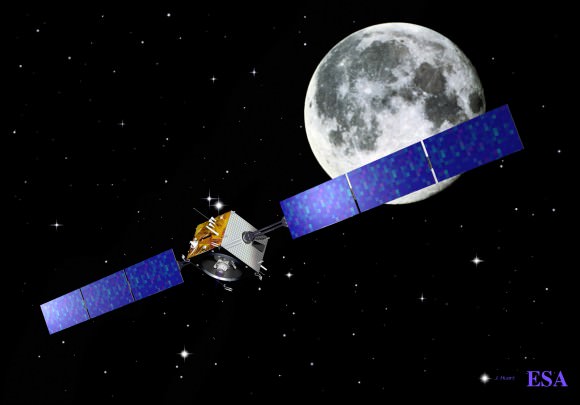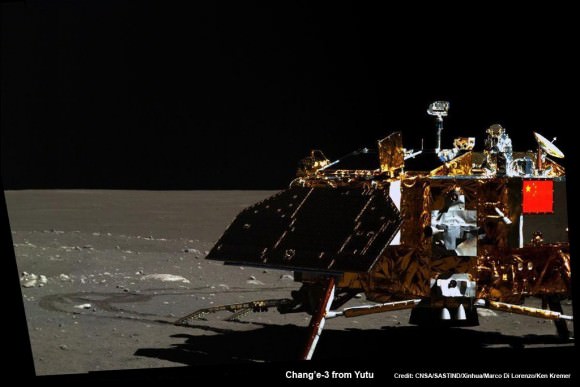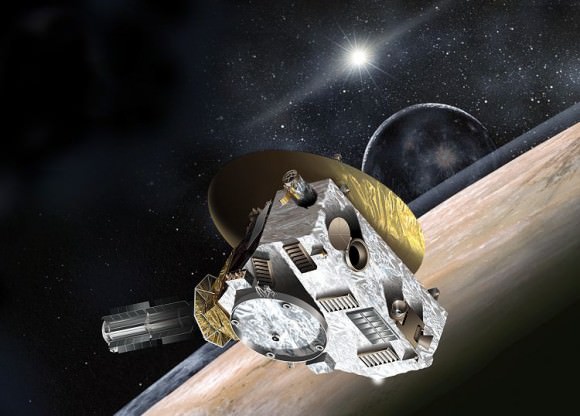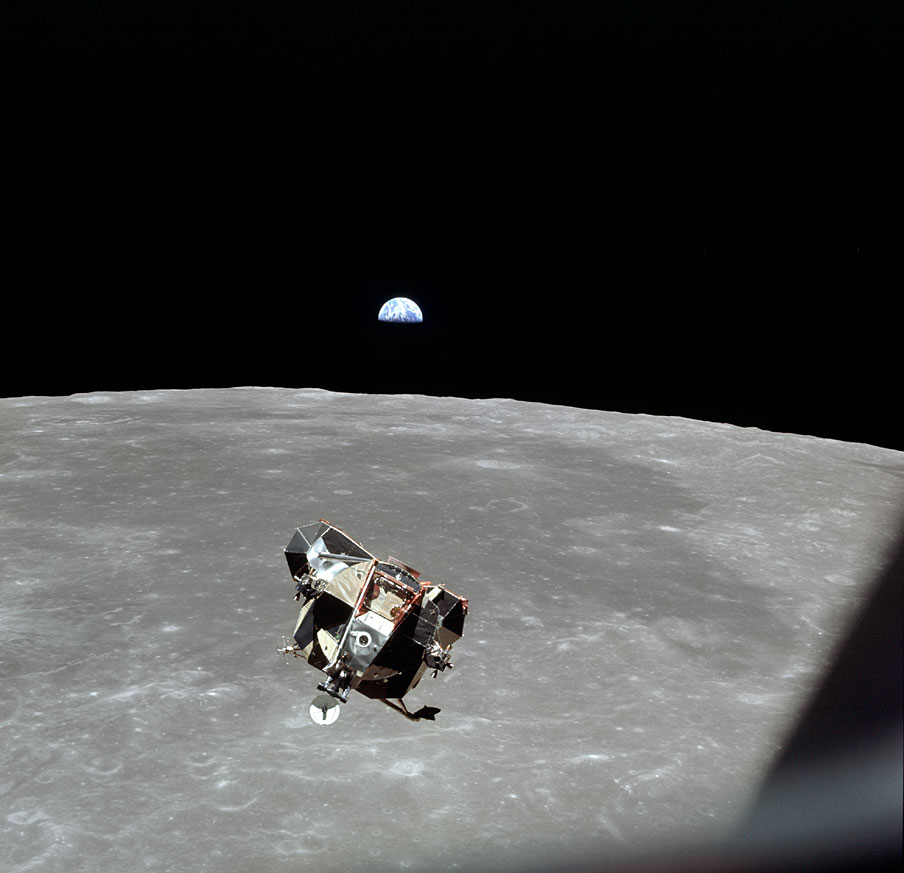Back in 2008, Richard Branson outlined his vision for Virgin Galactic’s future. Once tourists are taken into Earth orbit, it seems possible that space hotels could be developed for longer stop-overs in space. He then went on to mention that short “sight-seeing” tours to the Moon could be started from these ultimate hotels. If we are to make travel to the Moon routine enough to send tourists there, the trip would need to be as short as possible.
So how long is the commute from the Earth to the Moon anyway? Human beings and machines have made that trip on several occasions. And while some took a very long time, others were astonishingly fast. Let’s review the various missions and methods, and see which offers the most efficient and least time-consuming means of transit.
Many missions have arrived in lunar orbit and landed on the lunar surface, but the means of getting there are widely varying. Whether a mission uses a rocket to blast its way there, or a subtle ion engine to slowly edge its payload closer, we have many options open to us when we travel to the Moon in the future. To this end, I’ll give a quick rundown from slowest to fastest flights to Earth’s natural satellite 380,000 km away.
Unmanned Missions:
The slowest mission to fly to the Moon was actually one of the most advanced technologies to be sent into space. The ESA’s SMART-1 lunar probe was launched on September 27th, 2003 and used a revolutionary ion engine to propel it to the Moon. SMART-1 slowly spiraled out from the Earth to arrive at its destination one year, one month and two weeks later on November 11th, 2004.

SMART-1 may have been slow, but it was by far the most fuel efficient. The craft used only 82 kg of xenon propellant for the entire mission (ending with a lunar impact in 2006). The SMART-1 mission is an oddity as it is by far the longest mission to the Moon, the rest of the missions took a matter of days to reach lunar orbit.
China’s Chang’e-1 mission was launched from Xichang Satellite Launch Center on October 24th 2007 but sat in Earth orbit til October 31st when it began its transit to the Moon and arrived in lunar orbit on November 5th. The mission therefore took five days to cover the distance, using its rocket boosters. This was followed up by the Chang’e 2 orbiter, which launched on Oct 1st 2010 and arrived in lunar orbit within 4 days and 16 hours.
More recently, Chang’e 3 probe and lander launched on Dec. 1st, 2013 at 17:30 UTC and arrived in Lunar orbit on December 6th at 9:53 UTC. It was therefore the fastest of the Chang’e missions, taking 4 days, 12 hours, and 23 minutes to reach the Moon before deplyoing its lander to the lunar surface.

However, it was the first-even unmanned mission to the Moon that was the fastest. This mission was known as the Soviet Luna 1 probe, which completed a flyby of the Moon in 1959. This basic, but pioneering probe was launched on January 2nd and flew past the Moon by a few thousand kilometers on January 4th. It only took 36 hours to make the trip, therefore traveling an average speed of 10,500 km/hr.
Manned Missions:
The Apollo missions, which were the only manned Lunar mission, were fairly quick in reaching the Moon. Naturally, it was the Apollo 11 mission, where Neil Armstrong and Buzz Aldrin became the first men to walk on the Moon, that made the greatest headlines. This mission began on July 16th, 1969, where a Saturn V multi-stage rocket took the astronauts from Kennedy Space Center into orbit.
They reached lunar orbit after only 51 hours and 49 minutes in space, arriving on July 19th, 1969. The famous “One small step for man…” speech would not take place until July 21st, roughly 109 hours and 42 minutes into the mission. After dusting off from the Lunar surface, the Lunar Module spent another 2 days, 22 hours and 56 minutes getting back to Earth. So in addition to be the first manned mission, Apollo 11 was also the fastest trip to the Moon where astronauts were involved.

Fastest Mission to Date:
By far, the fastest mission to fly past the Moon was NASA’s New Horizons Pluto mission. This mission had a speedy launch, with its Atlas V rocket accelerating it to a a speed of about 16.26 km per second (58,536 km/h; 36,373 mph). At this rate, it only took 8 hours and 35 minutes for it to get to the Moon from Earth. Quite a good start for this probe, which was on its way to Pluto and the Kuiper Belt at the time.
Although this is impressive, it’s worth keeping in mind that New Horizons was not slowing down to enter lunar orbit (as was the case all of the manned and unmanned mission to the Moon mentioned above). Hence, it was probably still accelerating long after it had placed the Moon in its rear view mirror (assuming it had one).
Mission concepts like the Space Launch System and Orion Multi-Purpose Crew Vehicle (MPCV) will also come into play in the near future. On December 5th, 2014, an unmanned test of the Orion capsule took place, officially known as Exploration Flight Test 1. Having launched atop a Delta IV Heavy rocket, the capsule reached Low Earth Orbit, achieved two orbits of the Earth, and then splashed down again 4.5 hours later.

During the course of the flight, EFT-1 reached speeds of up to 8.9 km/s (32,187 km/h; 20,000 mph). At this velocity, an Orion mission could conceivably make it to the Moon (at an average distance of 384,400 km) in nearly 12 hours. Obviously, adjustments will have to be made for weight (since it will need a crew), and deceleration. But still, that’s not a bad framework for a tourist flight.
So, when space tourism begins mounting sight-seeing tours or missions to the Moon, they will have a few options. They could offer long cruises, gently gliding to the Moon using ion engines to slowly let the tourists take in the views. Or they could opt for the exhilarating rocket ride of a lifetime, blasting tourists off into space and whipping them back in just a day or two. Hard to say which one people would prefer, but surely there are many who would pay handsomely for the opportunity.
We Have written many interesting articles about the Moon here at Universe Today. Here’s Who Were The First Men On The Moon?, How Many People Have Walked On The Moon?, What Is The Distance To The Moon?, and You Could Fit All The Planets Between The Earth And The Moon.
For more information, be sure to check out NASA’s page on The Earth’s Moon and Solar System Exploration Research Virtual Institute
Original publication date April 10, 2008


Ian:
I think I’d go for the quicker ride using chemical propulsion rather than the Ion propulsion option. While Ion propulsion would be far more fuel-efficient and several times faster than chemical propulsion — “in the long run” (it takes a lot of time to build up acceleration) — the tourist(s) onboard would die of boredom or old age 🙂 The additional mass of each tourist would only hinder the delay-time for an appreciable thrust to build up in the spacecraft, and having gained that thrust, how, afterwards does one slow it down again — the Ion propulsion system just wouldn’t be strong or quick enough for decelleration requirements. A chemical propulsion system, on the other hand, would do, however, that means adding fuel onboard which increases the mass again, and means a longer period to build up acceleration. A combination of the two (Ion and Chemical) is inevitably the answer down the line, however, these would probably be more applicable for trips to Mars and other planets/moon in our Solar System.
Joel:
This sounds like the ideal time-requirement for the tourist(s) involved, and I don’t think the health problems associated with radiation risks…etc., would come into play if you stuck to your overall trip time-period as stated. Don’t know if I would survive those G’s you mention, however, please put me down for a trip when it eventually gets going (just mention my name to Richard — he’ll understand :-))
John — http://www.moonposter.ie
Moon News — http://www.moonposter.ie/news.htm
Moon Missions — http://www.moonposter.ie/missions.htm (Kaguya, Chang’e-1, Chandrayaan-1, LRO, GRAIL & LADEE, LunaGlob, LEO, MoonLITE)
John:
What about more powerful ION drives? We could use a Earth-orbit space laser to power the drive.
What about photonic drives?
In 2006 “Dr. Young Bae of the Bae Institute first demonstrated his Photonic Laser Thruster (PLT) with an amplification factor of 3,000”
The paper says ~1mN per 10 watts and no reaction mass required.
http://baeinstitute.com/downloads/STAIF_2006_YK_Bae_FF_Paper.pdf
On paper, presuming slightly higher than a 300 kilometer orbit, with as low as possible an eccentricity and as near to originating in a low earth orbit well aligned with the plain of the moon’s orbit – our hypothetical Virgin Lunar spacecraft could, in theory, accelerate from 7330 meters per second to around 18,500 meters per second in around eleven minutes, while pulling from 1.8 to a high of 2.5 gees, arriving in the lunar vicinity in from 6.9 to 7.5 hours, depending on whether the destination was at it’s highest or lowest point in distance from Earth.
Of necessity, this TLI would result in anything but a free-return trajectory, of course, and breaking to slow for lunar orbital insertion would require just as rough and an even more sustained burn that would begin while while still nearly ten lunar radii distant from the closest passage over the 174 to 179 meridian – and end minutes before Loss of Signal, and in lunar orbit watching, an earthset. in a retrograde orbit falling around the moon’s farside.
Presuming one had enough fuel and very few and very hardy passengers, and were not attempting a landing, the return trip could be executed in a longer period after a shorter burn only half of which would still be underway at earthrise – mainly because it would originate from an orbital speed around the moon of ~1.6 kilometers per second and because my orbital mechanic skills breaks down quite a bit at this point … causing the margin of error to require a range of 11.9 to well over 24 plus hours to safely return to lunar orbit.
Either way, the tolerances clearly exceed the comfort and fuel requirements of any craft ever constructed, but, hey, the exposure to Van Allen radiation, solar protons and cosmic rays would certainly be reduced!
Nevertheless, one could hardly call such highly hyperbolic moonstorming “safe!”
Still, it’s interesting to consider the possibility of arriving at the moon in less time than many trans-Atlantic flights. It would be a the ride of a lifetime.
On second though, scratch that lunar meridian number. That is, of course, not correct. And forgive the typos. In an emergency situation requiring medical help for lunar missions, I think we’ll continue our work with telemedicine and biorobotics. LOL.
J45ON:
But won’t both ‘Ion’ and ‘Photonic’ drives as means of propulsion systems still require build-up times that the tourist(s) onboard the craft will have to wait for. There’s no doubt in the technology that both systems (and other systems like solar sails etc.,) produce propulsion, however, their use for getting the tourist(s) onboard to the Moon in any reasonable time is just too long, isn’t it? Those onboard would, therefore, end up waiting and waiting for any significant thrust to get moving close to the necessary speeds required, and by that time their patience would have run out.
I looked at that paper you suggested and it’s obvious the research is based around micro, pico and nano satellites flying in formation (forgive me if I don’t fully understand their findings as I’m not an expert), but the propulsions quoted are for satellites weighing in from 10 – 100 kg. At minimum, spacecrafts [with toursist(s)] going to the Moon currently weigh in at their tonnage, and if they were to have an independent, proposed Ion and Photonic propulsion system onboard, these systems would have to be huge again for any appreciable output in light source requirements to get them moving, wouldn’t they? That means additional mass, which means build-up times are longer again, which means bored-to-death (dead) tourist(s) that never even get close to the Moon in sutiable times that they can endure.
John — http://www.moonposter.ie
Moon News — http://www.moonposter.ie/news.htm
Moon Missions — http://www.moonposter.ie/missions.htm (Kaguya, Chang’e-1, Chandrayaan-1, LRO, GRAIL & LADEE, LunaGlob, LEO, MoonLITE)
The ion slow boat to lunar absorption will become a religious pilgrimage.
Why not just go the traditional 2-3 day route and have photgrahic equipment on board to be able to “sight see” the cosmos while enroute?? There are plenty of things worth seeing in our own galaxie that could be easily glimpsed while on the way. Modern astronomy is incredible!
Personally I could never be “bored” or even SLEEP on a three day trip to the moon. By the time I was done looking at Earth, the next day would be spent looking at the moon and visa versa. You would never see the same spot for very long anyway or see “it all”.
We truely have the attention spans of a gnat when we talk of being “bored” on a 2-3 day trip to the moon!
We should be ashamed of that American trait !!!!!
Fraser and Ian, thanks for this insightful article, but it would be nice if someone were to suggest a practical schedule for getting to the moon. Traveling at more than 1.25 g is probably not a good idea for overweight, smoker tourists and traveling ad less than .75 g might also have its risks, so what if we traveled somewhere inbetween, and what if we varied the length of acceleration.
Of course, the best and fastest way to get to the moon would be to simply build very powerful and long range transporter beams (grin)
If we could build a spaceship capable of 1G constant acceleration / deceleration for extended periods of time, then (if my calculations are correct) we could travel in comfort from Earth to the Moon in about 3.5 hours. One G accleration to the midway point takes about 1.75 hours, followed by 1G deceleration to reach the moon). This assumes we could turn off the engine and rotate the ship quickly at the midway point, with the passengers being weightless then.
thats gonna be a lot of burnt up fuel that will be just ‘gone’. I think we need use use mini nuclear power or something new.
This type of trip would be a dream and fantastic to anyone old enough to be a kid in the early 70s. I know that I have always wanted to go into space, orbiting the moon would be even that much better.
One has to wonder how quickly the price for such travel could become realistic and of course once the excitement in lunar orbits wears off for the populace in general I am sure an actual lunar landing and bouncing around on the moon would be one of the greatest adventures anyone could dream to go on.
I have to agree with Gudenboink, there is no way that anyone could get bored on a trip like this, anyone that could get bored on this grand adventure would not be interested in going in the first place.
I think that if they were to bill it as a two week “cruise” to the moon, it would work out the best. People spend weeks at sea on these cruise ships with nothing but the big blue to see- but there are other sources of entertainment during their trip.
Also, using a dedicated ship in space to travel to the moon seems to be the most practical. Launch into space in a rocket, dock with the “cruise ship” where you offload the fuel and other supplies, and then you are on your way. Once you return, you dock again with another ship bringing up passengers, and they take down those that are returning. This mode seems the most cost effective, as you are not launching the mass of the lunar transport vehicle, just the payload.
just my .02
Baggage allowance?
Overweight baggage fees?
Would it be cheaper for lighter folk, excellent excuse to lose some pounds
k.
Fitness Guy & Gudenboink:
On boredom …etc. I was really talking in the context of using an Ion and Photonic driven spacecraft — it could take upto several weeks and months (years???) to get you and others to the Moon using these systems.
But as for the three-day trip to the Moon…I’d have one eye on the receding Earth below, the other eye on the expanding Moon above, and I difinitely wouldn’t be bored (or boring, as I may have come across in my comments re: Ion/Photonic context…SORRY!).
John — http://www.moonposter.ie
Hi All
An Apollo 8 or 10 free-return trajectory will be the preferred option as high-speed means tons more propellant and, unless you’re landing, not a lot of loitering time near the Moon.
The whole subject of tourist travel in space is moonshine until there is a space elevator to reduce the cost of moving mass to earth orbit by orders of magnitude.
“…[New Horizons] was probably still accelerating as the Moon was a dot in its rear view window”.
Bzzt wrong. The initial boost only lasted a few minutes. New horizons only accelerated once once it passed the moon and that was the Jupiter gravity assist.
To ioresult:
Hehe, got me there. Damn! (But you can see by my uncertainty when I say *probably*.) Thanks for the info, good to know. Wow, that’s one hell of a boost!
Cheers, Ian
Si en el futuro el viaje a la Luna será algo tan rutinario como para enviar turistas, el viaje deberÃa ser lo más corto posible. ¿Pero cuánto tarda un viaje a la Luna? Hombres y máquinas ya han hecho ese viaje, algunos tomaron mucho tiempo y otros fueron increÃblemente veloces. […] Ian O’Neill para Universe Today
I personally think this is just a ploy to gain money and raise attention however my heart says I hope it is true
The sooner we start space touring and colonization the better. Humanity needs to span outwards to survive.
its rubbish
I have to agree with Richard Branson. Why not build hotels in space? That way the tourists can travel to the space hotel in a standard rocket (where they can experience the thrill of high g-forces). Thenonce they get to the space hotel, wait a few hours or days experiencing weightlessness, then take a shuttle to the Moon, using the Earth’s gravity as a slingshot effect to reduce fuel costs, then voila, the moon! On the return trip back to the space hotel, they can use the Moon’s gravity in a similar slingshot effect to get back to Earth. Of course, only the filthy rich tourists will help pay for the luxury of going to the Moon, while the rest of us cretins will grumble and complain, at least in the beginning. Someday going to the Moon will be comparitively expensive as having a car, or a personal computer. Does anyone remember how expensive they were when they first came out???? 😀
Rocket Maaaaaan! It would be cool to go up there.
Are humanity close to build a space ship capable of 1G constant acceleration as Phil Jackson says?
I hope Branson’s Lunar Service is better than Virgin Media Broadband and Virgin Trains, which are appalling – otherwise it is a belt ‘n’ braces job.
this is some verry interesting information. how long would this even take?
For fuel cost’s sake, because I’m assuming that rocket fuel costs quite a bit, why not consider an H2O electrolysis based rocket? Have a huge water tank, a small nuclear reactor onboard (or some other high energy production device), then split the water into HHO and burn it for the fuel.
It might make hydrolygists upset if a considerable amount of Earth’s water is taken out of our atmosphere never to be recollected, but humans use now and worry later right?
i what to no how long does it take to get to the moon fast
can i get a dvd of the solar for my home?
What is the average time to get to the moon?? PLease I really want to know…
I can’t wait until all of this becomes a reality!!!
it is sooooooooooooo amazing how fast you can get to the moon!
Want to take a ride to the moon! well am Gone…… i´ll be back in 17.10hrs